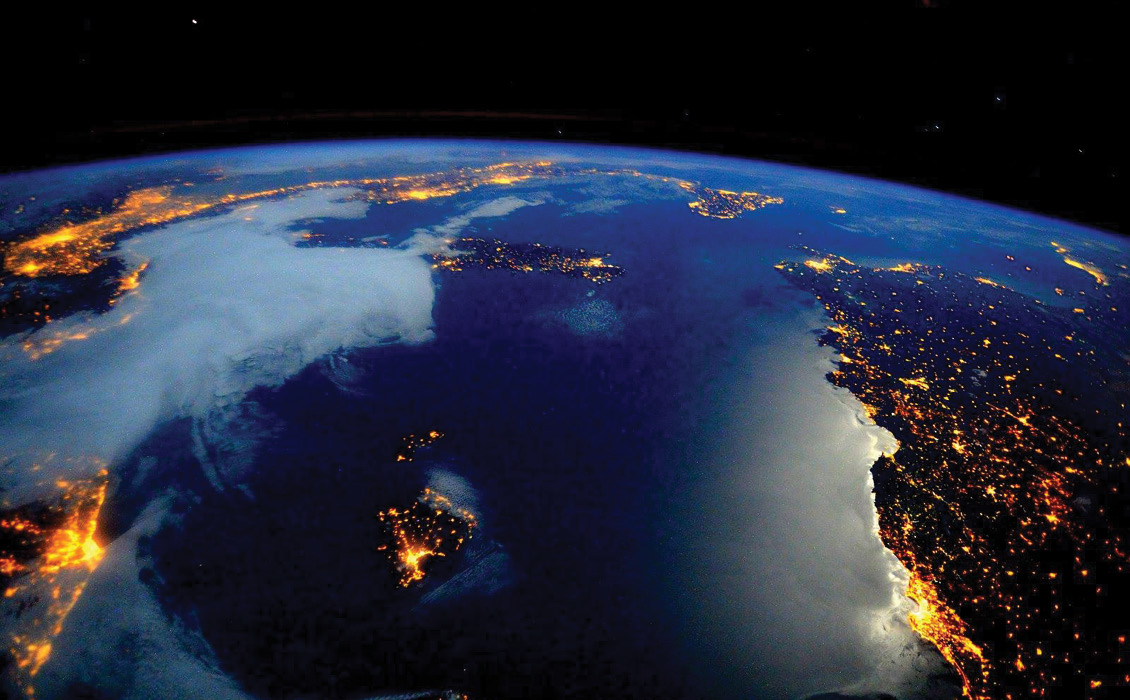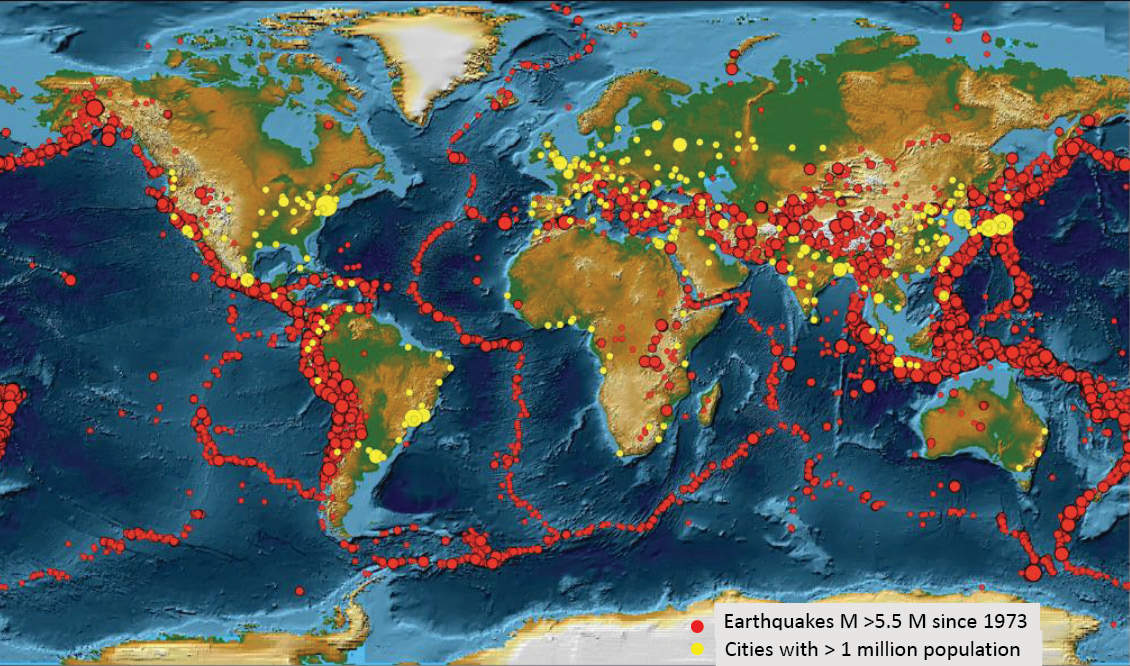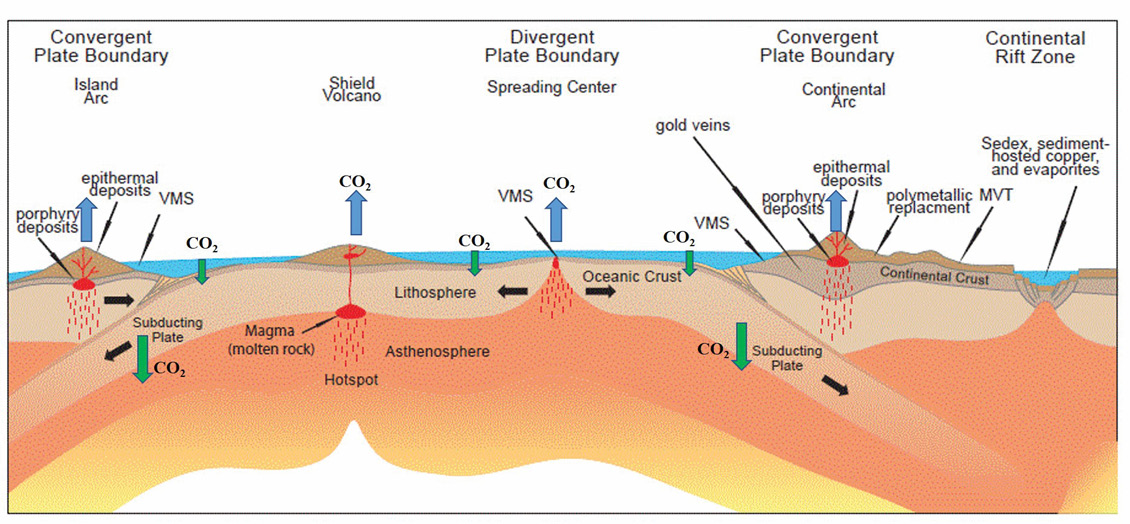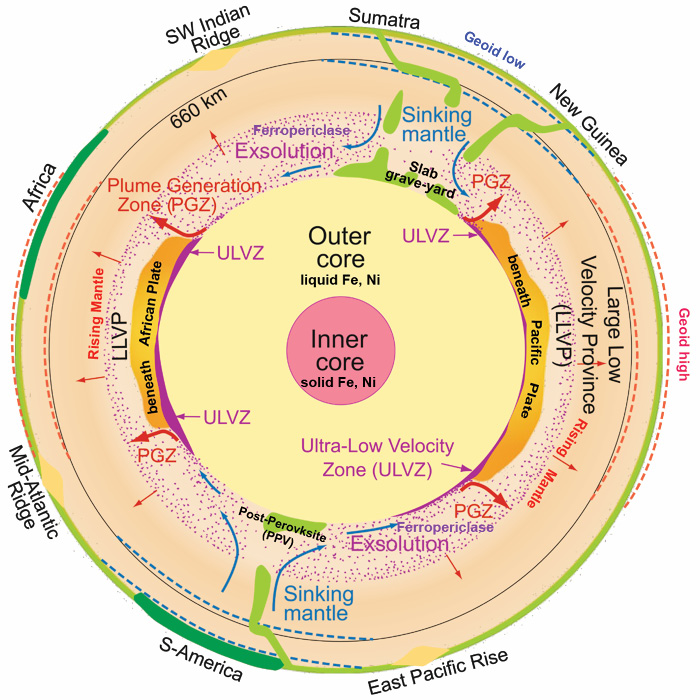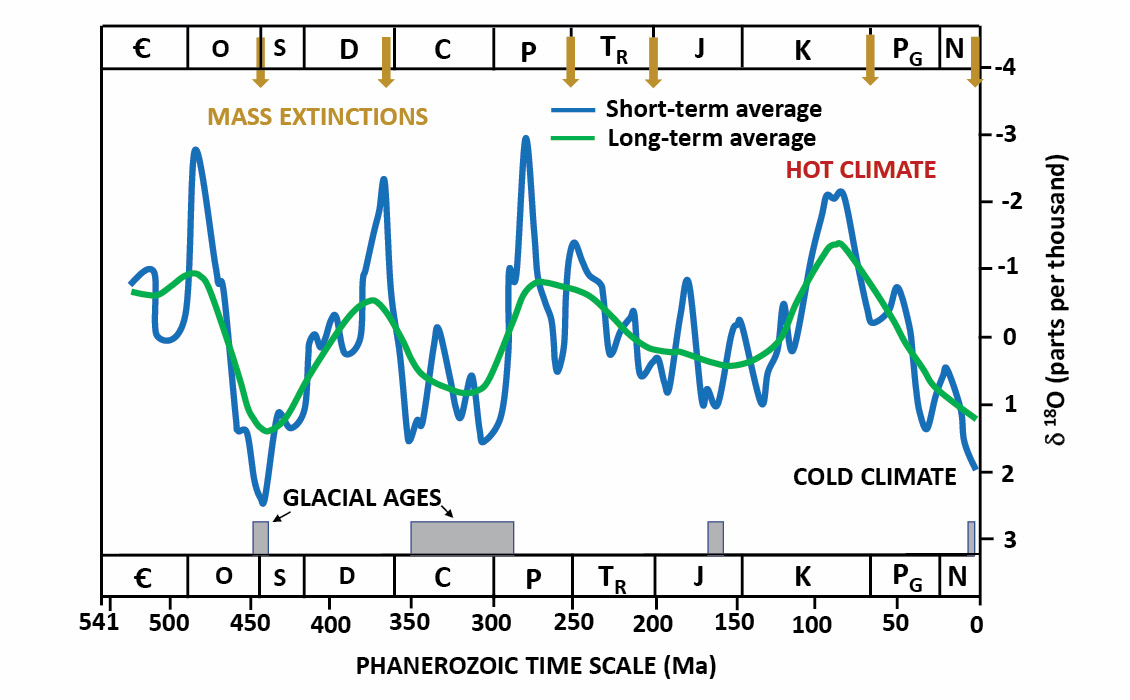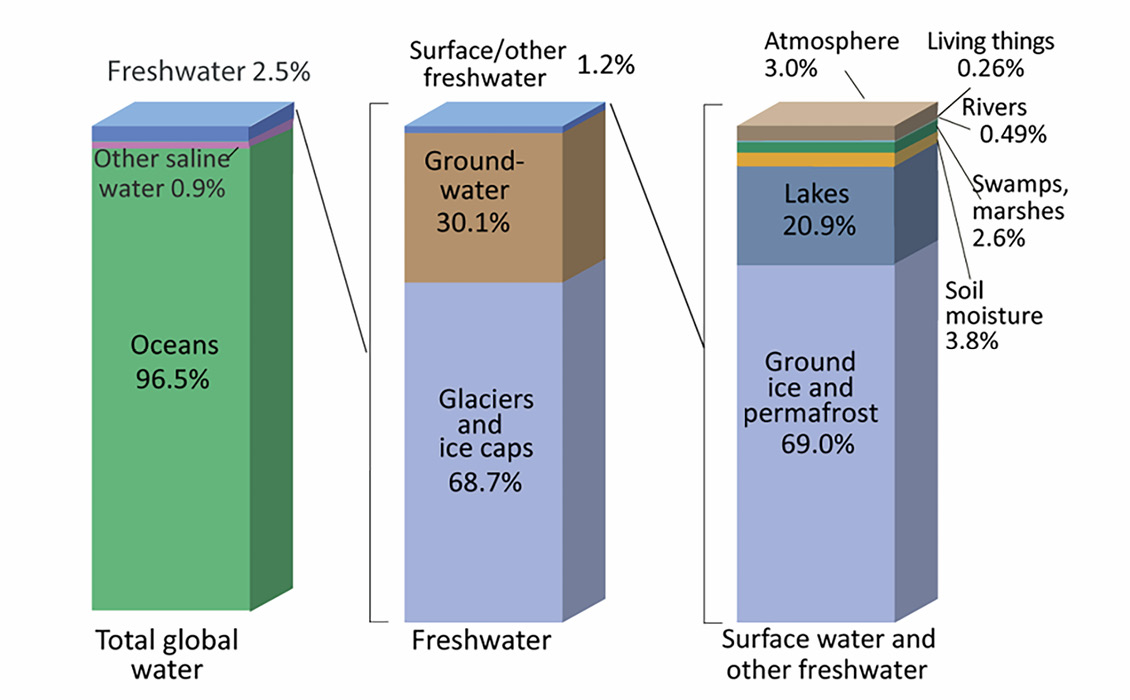During 2019–2020 I undertook a survey of the most important questions in geoscience and crucial challenges facing the geoscience community. The survey was conducted through emails sent to hundreds of geoscientists and also posted through community websites of the Geological Society of America, American Geophysical Union, and American Institute of Professional Geologists. The scientists were asked to suggest up to five most important questions in geoscience (including geology, geochemistry, geophysics, and applied geology, but not regional geology) or issues facing the geoscience profession. A total of 136 scientists (75% from the USA, and 75% from academia) responded, and together they suggested 370 questions, many of which overlapped. This article is based on the survey results but written in a thematic style.
Global Warming
A large number of respondents suggested that global warming is the most critical issue of our time. This complex issue involves many areas of research including in-depth understanding of climate change, carbon budget and cycle, CO2 sources, fluxes and sinks, climate change drivers and feedbacks (both negative and positive feedbacks), better forecasts and modelling of the impacts of global warming on ecology and societies, and more importantly working out technological and policy solutions to reduce the emission of greenhouse gases from fossil fuels into the atmosphere.
Future Energy and Petroleum Industry
Closely related with the global warming is the status and future evolution of the petroleum industry. Historically, the petroleum industry has funded numerous research studies and hired a large number of geology, geophysics, and engineering graduates. Given worldwide movements to combat global warming, the future of the oil and gas industry is not clear. Will the industry evolve and reinvent itself, or will it gradually give way to other energy, mineral and environmental industries; and if the latter, will these industries be geoscience-intensive and highly supportive of research and education?
The petroleum industry needs to address both environmental sustainability and financial challenges. To be environment friendly and reduce its carbon footprint, the industry has to invest in the science and technology of carbon capture, reuse or storage, avoid gas flaring, and control methane emissions from shale oil and gas fields. To reduce its costs per barrel of oil production and be profitable for its stakeholder, the petroleum industry must utilise smart data science and more efficient technologies for better subsurface imaging and improved recovery of oil and gas.
The world (as well as the geoscience community) is facing a big dilemma. On the one hand, the catastrophic threat of global warming is a genuine reason to move towards energy sources with the smallest carbon footprint. On the other hand, energy-dense fossil fuels currently account for 85 percent of the world’s energy supply, and a rapid transition to replace fossil fuels will have its own political, economic, and technological challenges and consequences. Added to this dilemma is the fact that global energy demand will grow (not decline) in the coming decades because the flow of affordable and abundant energy is critical to the living standards of the developed world and development of low-income nations. These trends provide geoscientists with both challenges and opportunities in developing new energy technologies.
Earthquake Prediction
Seismology and plate tectonics have made great strides in our knowledge of earthquakes – how and where they occur. Nevertheless, predicting the timing of earthquakes remains a most serious problem, despite the recognition that certain physical precursors provide helpful clues. Given that a large number of megacities are situated along the tectonically active circum-Pacific and Alpine-Himalayan belts, big earthquakes are indeed silent ‘time bombs’ and require intense studies.
Plate Tectonics
Plate tectonics was a revolutionary discovery in 20th-century science. It has provided a unified theory, a new paradigm, to explain various, seemingly unrelated, geologic phenomena from the rock cycle and mountain uplifts to mineral deposits and earthquakes. Nevertheless, many aspects of plate tectonics still remain poorly understood and require sophisticated studies. For instance, we still do not know when and how plate tectonics began in the Precambrian Earth; how our planet functioned before plate tectonics; and what critical mass of conditions triggered plate tectonics. We also need to know detailed mechanisms of how plate tectonics affects the oceans, the atmosphere, and the biosphere, and how plate tectonics controls the generation and distribution of mineral resources. Volcanic eruptions occur at the boundaries of tectonic plates as well as at the hotspots of mantle plumes. But how exactly does an explosive volcano start and end, and how can we model these two conditions?
As far as we know, Earth is the only planet in our solar system that displays active plate tectonics. How long will the plate tectonics last? What might cause its cessation?
Mantle Dynamics and Plumes
Our geologic knowledge largely pertains to the crust accessible to us; but the crust is merely a thin skin of the global volume. Lithospheric plates are controlled by dynamic forces in the mantle, from the asthenosphere immediately below the lithosphere all the way down to the low shear velocity provinces surrounding the outer core. The mantle remains terra incognita and thus a new frontier. Our physical access to mantle plumes is restricted to hotspot magmatism on the Earth’s surface. Where do plumes rise from? How can we classify plumes, physically and compositionally, to understand processes of their formation? How can we study the evolution of the mantle over geologic time as we do for the crustal rocks?
Earth’s Magnetic Field
The Earth’s magnetic field originates from the circulation of liquid iron and nickel in the outer core, and its influence reaches beyond the solid Earth and protects life from harmful solar and cosmic radiations. We also know that the Earth’s magnetic poles have reversed their position through geologic time; however, we still do not know exactly how and when these reversals take place.
Origin of Life
Life begets life, and life forms on Earth have evolved; but how, when and in what environment did the first cells and the earliest microorganisms emerge? Did life originate independently on Earth some four billion years ago (if not earlier) from a ‘primordial organic soup’ (abiogenesis) in the Earth’s early oceans, or were biological molecules brought to Earth from outer space by asteroids and meteorites? The genesis of life on Earth, like other phenomena, has a naturalistic explanation, but it still remains a mystery in science. Nevertheless, the search for ‘theories of life’ aids exploration of life on other planets and also deepens our understanding of survival mechanisms of microorganisms in extreme environments.
Cambrian Explosion
The Precambrian–Cambrian transition marks a benchmark in the history of Earth. It marks a time of drastic changes in the atmosphere (oxygenation), tectonics (assembly of Gondwana), and evolution (proliferation of multicellular organisms or what has been dubbed as the Cambrian explosion). Understanding the nature of this time interval and the interconnected phenomena leading to the Cambrian explosion of life is an important question in the history of our planet.
Climates of the Past
Studies of the history of Earth’s palaeoclimate involves a wide range of questions such as: What were the causes and effects of drastic variations in the atmospheric composition (especially O2 and CO2) over geological time? What factors determined the onset and termination of greenhouse periods and glacial periods? How did the biota respond to such drastic climate changes? Some of these geologic periods are particularly attractive for geoscientists, such as the ‘Snowball Earth’ of the Cryogenic period, mid-Cretaceous hothouse, Palaeocene–Eocene thermal maximum, and Quaternary ice ages.
Mass Extinctions
In a mass extinction, a large percentage of higher taxa in several biological groups vanish within a brief interval of geologic time either due to ‘bad genes’ (natural selection) or ‘bad luck’ (catastrophic events) – to quote David Raup’s 1991 book. Extinction is a rule rather than an exception and at the species level, over 99 percent of life forms have become extinct over geologic time, with the ‘big five’ events in the Late Ordovician, Late Devonian, Late Permian, Late Triassic, and Late Cretaceous each wiping out more than two-thirds of species. Obviously, understanding the causes and consequences of these mass extinctions is not only a matter of curiosity, but also importance for our own survival. Sadly, humankind in recent decades has also been responsible for the ‘sixth’ big mass extinction through natural habitat destruction.
Exploration of Mineral Resources
Mineral exploration has always been at the heart of geoscience because everyday life, industries and economies all depend on a vast number of minerals and elements. This field is expected to grow as global demand for minerals increases, and strategic (critical) minerals including rare-earth metals will dominate national security and geopolitics. Improved knowledge of reserve estimates, geographic distribution, geological concentrations, and industrial recovery of critical minerals and elements will be important tasks for economic geologists.
Natural Hazards
Natural hazards are routine geologic processes; however, their tragic impacts on human life, structures and properties have increased due to population growth and concentration in megacities prone to natural hazards as well as unpreparedness especially in developing countries. Natural hazards include a diverse set of events resulting from tectonic, hydrological, meteorological, and climatic processes, and many of them are interrelated, such as offshore earthquake-tsunami coupling. During 2000–2009, more than 7,000 geophysical disasters killed approximately 1.23 million worldwide. Geoscientists and engineers can greatly contribute to studies of the precise mechanisms of natural hazards, risk assessments and mapping, warning systems, mitigation and construction of hazard-resistant structures.
Water Resources
Underground and surface freshwater resources used for drinking, irrigation and other residential or industrial needs constitute only one percent of the global water budget. Although water is a renewable resource, freshwater resources are unevenly distributed both seasonally and spatially, depending on terrain and climate. Geoscientists and engineers will play an important role in detailed studies of the hydrological cycle and water budget, reservoir mapping and extraction of groundwater, water resource management especially in arid environments, optimal practices of watershed modification, desalination projects, and so forth.
Environmental Geology of the Anthropocene
Human health intimately depends on the quality of the air, water and soil. Rapid and reckless industrialisation of the world has caused environmental destruction and pollution of various types. The recent designation of the Anthropocene as a geologic age (beginning at around the 1950s) is a testimony to our (often adverse) impacts on almost every part of the planet from the atmosphere and the oceans to landscape and forests. Loss of biodiversity due to destruction of forests (with species that will never come back), desertification, silent erosion of topsoil (that will take centuries to recover), plastic pollution of the oceans, are tragic records of the Anthropocene. Environmental geology is thus a great contribution of geoscientists to society, and the significance of this field and the workforce needed for its multitude of tasks are expected to rise in the coming decades as human–Earth interactions will intensify.
Meteorite Impacts
There are 190 confirmed impact structures on Earth, ranging in age from 7 years to 2.4 billion years and they are found on all continents except for ice-covered Antarctica. (Antarctica, however, is a hunting ground for meteorites themselves.) All of the impact structures have been recognised since 1950 and are thus a very tiny portion of impact events whose records have been obliterated by erosional processes. Impact structuring as preserved on the Moon has been closely associated with the early history of planets including Earth. The disastrous consequence of extra-terrestrial impacts on ecosystems is obvious, although its details require in-depth studies. At least in one popular case – the Cretaceous–Palaeocene boundary – impacting seems to be responsible for a global mass extinction. This necessitates monitoring large asteroids or meteors approaching Earth head-on, and if necessary, destroying them or diverting their courses physically. Another question is: Do large impacts affect the Earth’s surface only or do they also cause perturbations in the mantle, perhaps even as deep as the core–mantle boundary?
Earth–Moon Relationship
Earth’s only natural satellite is a unique feature in the Solar System. Isotopic signatures indicate that the Moon resembles an early lifeless rocky Earth, and according to a widely held hypothesis the Moon’s materials were split off from Earth as a giant body, Theia, hit the proto-Earth. Whatever the mechanism for the origin of the Moon, the Earth–Moon companionship has been a long story of mutual gravitational influences. Aside from the tidal waves on Earth, we also know of moonquakes produced by Earth’s gravity. Does the Moon’s gravity also influence earthquakes and exert tidal stresses on Earth’s topography and fluid pressures in rocks? We also need a better understanding of the daylength and Earth–Moon distance over geological time – a field of research that amazingly relies on coral palaeontology developed in the 1960s.
Geoscience in Public Education and Policy
Most people, including young children, are interested to learn about minerals, fossils, life of the dinosaurs, how mountains uplift, and other geological lore. Ironically, however, earth science is relatively underrated in our high schools and the public mostly remains unaware of the remarkable progress geoscientists have made in the past century. How can we communicate the value of geoscience to the public, school boards, and policy makers? This is a crucial challenge for the geoscience community; it is also a task that only geoscientists should perform. We should also present a new public image of the geologist beyond one who mainly digs for fossil fuels and studies earthquake incidents.
Big questions in science are not limited to the Big Bang and black holes. For geoscientists, understanding the evolution and operation of our one and only planet and providing humanity with vital resources are of utmost importance.
References
- Allmendinger, R.W. and Shaw, J.H., 2000. Estimation of fault propagation distance from fold shape: Implications for earthquake hazard assessment. Geology, 28(12): 1099-1102.
- Raup, M.D., 1991. Extinction: Bad Genes or Bad Luck?: W.W. Norton, New York.
- Shiklomanov, I., 1993. World fresh water resources. In: Gleick, P.H. (ed.) Water in Crisis: A Guide to the World’s Fresh Water Resources: Oxford University Press, New York.
- Trønnes, R.G., 2010. Structure, mineralogy and dynamics of the lowermost mantle. Mineralogy and Petrology, 99 (3-4): 243-261.
- Veizer, J., Ala, D., Azmy, K., Bruckschen, P., Buhl, D., Bruhn, F., Carden, G.A., Diener, A., Ebneth, S., Godderis, Y. and Jasper, T., 1999, 87Sr/86Sr, δ13C and δ18O evolution of Phanerozoic seawater. Chemical geology, 161(1-3): 59-88
- Yeats, R., 2015. Earthquake Time Bombs. Cambridge University Press, Cambridge.
- Zalasiewicz, J., et al., 2018. Are we now living in the Anthropocene. GSA Today, v.18, no. 2, doi: 10.1130/GSAT01802A.1


